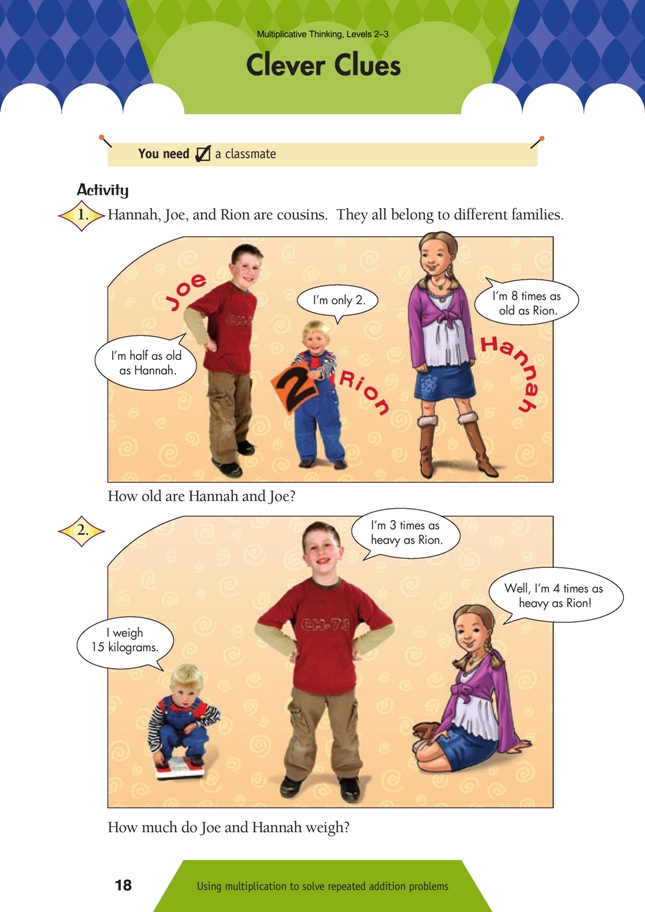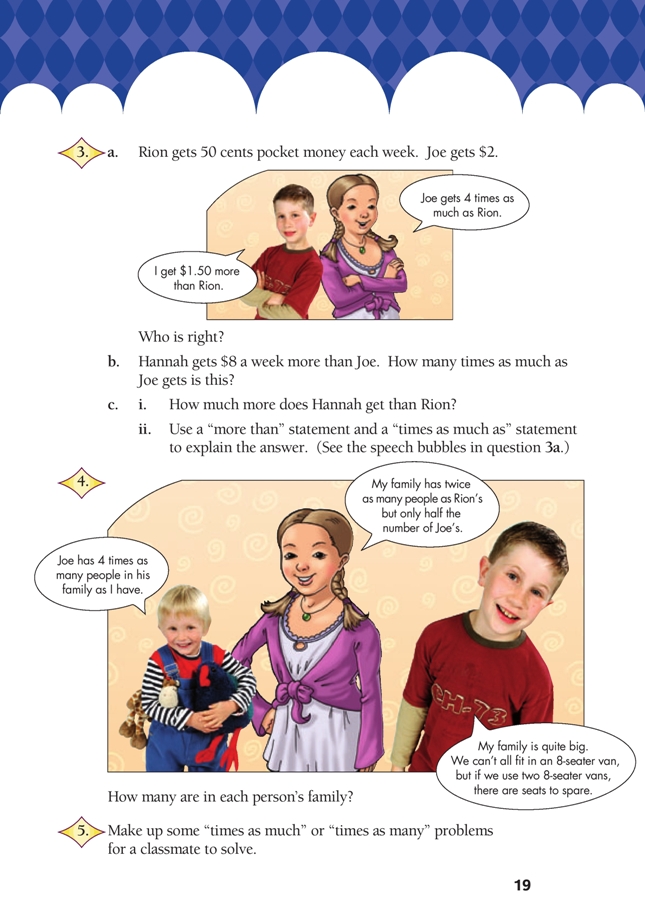This is a level 3 number activity from the Figure It Out series. It relates to Stage 6 of the Number Framework.
A PDF of the student activity is included.
Click on the image to enlarge it. Click again to close. Download PDF (724 KB)
solve problems using multiplication facts
Number Framework Links
Students at stage 6 will be most able to see the relationships and use the strategies needed in this activity.
FIO, Levels 2-3, Multiplicative Thinking, Clever Clues, pages 18-19
A classmate
This activity presents multiplication as multiplicative comparison problems. Students at all levels may need discussion to get them “into” the problems, which encourage doubling and halving and seeing a multiplicative relationship between amounts.
While the basic arithmetic of all multiplication problems is the same, the different situations that call for multiplication to be used have quite different structures. In this level 2–3 book, the Fishy Business problems are equal-groups problems, the most common way that we present multiplication to students. The Joust Away! pages are Cartesian product problems, in which two factors are combined to make pairs. Face the Facts uses an array model.
Multiplicative comparison problems express the relationship between things as “times as many”, comparing the two amounts with a multiplicative relationship. Although the arithmetic in these problems is simple, this presentation of multiplication is harder for students to decode. The multiplication is describing relationships between numbers rather than an operation to be performed, making it more difficult to extract what should be done. The students may read the clues and think that they don’t have enough information to solve the problem.
For question 1, discuss with the students where to start: What do we know? What do we need to work out next? They need to use Rion’s age to work out Hannah’s age, and then they can work out Joe’s
age. The only clue for Joe’s age is what it is in relation to Hannah’s age.
Question 2 is slightly simpler because both unknown quantities are described in comparison to a known amount. Encourage your students to try this and see if they can apply what they learned while solving the first question.
The students need to be able to generate their own statements in question 3. The “more than” statement is an additive comparison (sometimes solved as subtraction, but it is an additive process). The “times as much as” is a multiplicative comparison. This may require lots of discussion and support to generate. Modelling the amounts using 50 cent pieces might be helpful.
Encourage the students to use what they have already learned when they tackle the problem in question 4. (There are several pairs of numbers that could fit Rion’s and Hannah’s clues, but Joe’s clue tells you which to select.)
Question 5 involves comparison problems. The students will probably find writing these difficult. First, they need to identify a multiplicative relationship, and then they need to encode it in a problem format. They will probably think of additive problems instinctively: “I have 4 brothers and 2 sisters:
how many siblings do I have?” Help them to alter this to a multiplicative statement: “I have twice as many brothers as sisters, and I have 6 siblings altogether … How many brothers and how many sisters do I have?”
Preparing some pictures of different families for them to write about may help. Height comparison is a useful context (“I am half as tall as … and twice as tall as …”) or perhaps the number of pets in a family (“We have 4 times as many fish as guinea pigs …”). Drawing the relationship will give them something to refer to when they are trying to make it into a word problem.
Answers to Activity
1. Hannah is 16 yrs old (8 x 2 = 16), and Joe is 8 (16 ÷ 2 = 8).
2. Joe weighs 45 kg (3 x 15 = 45 or [3 x 10] + [3 x 5] = 30 + 15 = 45), and Hannah weighs 60 kg (4 x 15 = 60 or [4 x 10] + [4 x 5] = 40 + 20 = 60).
3. a. They are both right. (Joe’s answer uses additive thinking [50c + $1.50 = $2], and Hannah has compared the amounts multiplicatively [4 x 50c = $2].)
b. 5 times. (Hannah gets $10 a week [2 + 8 = 10], which is 5 times as much as
Joe: 5 x $2 = $10.)
c. i. $9.50.
ii. Hannah gets $9.50 more than Rion: 0.50 + $9.50 = $10; and Hannah gets 20 times as much as Rion: 50c x 20 = $10.
4. Joe has 12 people in his family, Hannah has 6, and Rion has 3. (Joe must have between 9 and 14 people in his family because they can’t fit in one 8-seater van, but if they go in two 8-seater vans, there are at least 2 seats to spare [Joe says
there are seats to spare, so that means at least 2]. Joe has 4 times as many people in his family as Rion does, so it must be a multiple of 4. 12 is the only multiple of 4 between 9 and 14, so Rion must have 3 people in his family and Joe must
have 12. Hannah has twice as many as Rion: 2 x 3 = 6, which is also half of Joe’s family: 1/2 of 12 = 6.)
5. Problems will vary.

